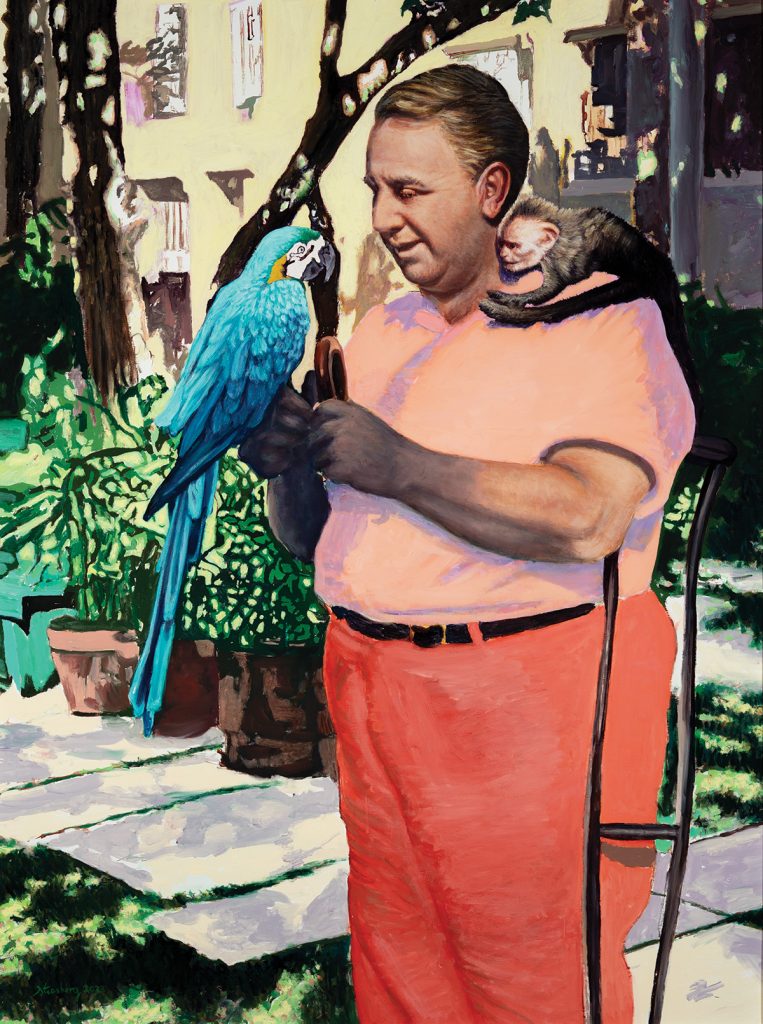Painter and Palm Beach resident Serge Strosberg doesn’t need to look far for inspiration. Hatched during the pandemic, his “Reimagining Palm Beach” series focuses on the dreamers and magnates synonymous with the town’s history. Working from vintage photographs, he has painted Henry Flagler, Marjorie Merriweather Post, Addison Mizner, the Vanderbilts and others in a motley, saturated style—“dressing” these titans in vibrant clothes from Lilly Pulitzer or Maus & Hoffman. Essentially, he transforms black-and-white images into polychromatic fantasias, much the way his subjects transformed swampland into a cultural oasis.
Born in Belgium and educated in art at France’s rigorous Academie Julian, Strosberg has painted since the age of 4, and his old-school medium—a viscous mix of oil and egg tempera—lends his work its distinctive aura. The county has certainly taken notice. Since 2022, Strosberg’s work has been exhibited at the Cultural Council for Palm Beach County, the Cornell Art Museum, the Palm Beach County History Museum, The Boca Raton and the Spady Museum. His latest extension of “Reimagining Palm Beach,” “Monkeying Around Palm Beach,” depicts Addison Mizner’s famous primate companion, Johnnie Brown, enjoying the finer things in life.
What compels you about painting the human form?
I think I come from a family of humanists—people interested in other people. It’s the way we were raised—very community-driven, always rooting for minorities, including ours; I’m Jewish. My grandfather saved 400 Jewish children during the Second World War. There’s a picture of him in the history museum in Palm Beach. My father is a famous scientist, and my mother has a Ph.D in chemistry. We are a family of people who care about other people, and for me it’s taken the form of portraiture and art.
Your recent work has focused on the icons of Palm Beach. What has come to inspire you about this island and the people who built it?
I was walking in Palm Beach, and COVID hit, and the whole town came to a standstill. I decided to go to the Flagler Museum, because I like history. And I’m looking at all these photographs of Flagler … and I thought it would be interesting to reimagine them in a more compelling way. I’m trying to be a bridge between the past and the present, maybe even the future.
But of course, the establishment is not really interested. There’s been a lot of support with what I’ve been doing, but there’s been a fringe that’s not been receptive to this, that wants things to stay exactly the way they are. I think it’s important, if they want to get the support and interest from new generations, to adapt, and think of new ways of showing the history of Palm Beach. I thought it needed an upgrade, if you will.

What is your approach to color and technique in the “Reimagining Palm Beach” series?
I think color is one of my assets. I’ve been mixing pigments for 20 years. … When you’re using pigments, it’s really like you’re cooking. When you’re preparing a meal, you know exactly how much salt and saccharine you’re going to add to the mix to make it more tasty. I’m doing the same thing with painting.
But there’s also something else. The technique that I use, the oil and tempera, also helps to create more depth in the painting, because the egg white creates a very strong light. So there’s a lot of contrast in the paintings. And of course, it makes them more alive.
In light of Boca’s centennial, you also painted Addison Mizner. What does your portrait hope to convey about the man?
It’s well known that Addison Mizner was the first major gay figure in Palm Beach County. But most of all, he was very eccentric. He was a bon vivant. So I imagined this guy larger than life, wearing pop colors, orange pants. I tried to make Addison Mizner like a modern LGBT Palm Beacher.
You’ve embraced the use of AI in your work. Did you initially feel any hesitation toward integrating it?
It was very experimental in the beginning. I was just using filters to retrieve pixels from old black-and-white photos. Then I started trying to create monkeys in PhotoShop. And I wasn’t satisfied with what I was getting at all. I would get three tails or four legs. But I discovered something very frightening but interesting: If you start creating something with all of this AI software, eventually the computer finds out what you like, and will curate it so that it will look more personal, and that no one can copy.
Once I have an image I like, I will transform that image, and that’s the beauty of this. I add my own tempera painting, my own colors, and it becomes something completely personal, and far from the flat AI images.
This story is from the May/June 2025 issue of Boca magazine. For more like this, click here to subscribe to the magazine.







